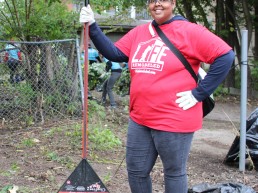Prioritizing Dental in a Pandemic
When the state of Michigan executive order required many businesses to shut down this past spring, Dr. Paul Crowley and his staff at Great Lakes Bay Health Centers (GLBHC) reimagined how they could continue to provide critical dental care.
“Our patient population – a lot of them are in pain,” said Dr. Crowley, GLBHC dental director. “Many patients have really deep cavities that may get to the nerve if they wait to get them fixed. We still had treatment we had to complete to stop their pain or prevent possible pain, with or without COVID-19 around.
“When patients have pain and don’t know where to go, their first stop can be at the hospital emergency room. We wanted to help keep hospitals free of as many dental patients as possible so they could treat those people needing emergency hospital care.”
GLBHC provides a vast array of services in the Great Lakes Bay area. Because the medical and dental teams are able to assist one another, paired with the large size of the dental team and at-risk patient population, GLBHC was able to remain open for emergency dental care.
Still – they had to make some changes.
One of their six dental clinics closed, and most dental hygienists were laid off – those kept on were relocated to the pharmacy to provide assistance. All 15 dentists were kept on staff, with one scheduled for emergency care each day with the help of two assistants. Dentists not on the day’s schedule were redirected to various GLBHC COVID-19 screening sites, but were available to assist in a dental emergency as needed.
Cosmetic procedures were limited, but GLBHC was able to provide other care like dentures, crowns, fillings and extractions to ensure patients would not have to live in pain during the stay home orders.
Patients were encouraged to call ahead of time but GLBHC never turned anyone away who showed up in need of emergency dental care. All patients were screened and processed in such a way that reduced waiting room traffic.
“We saw a lot of new patients, but obviously a lot of our own, too,” Dr. Crowley said. “A lot of dentists in the community couldn’t open up, so we saw a lot of new patients who needed one-time care. We just wanted to help the community and make sure we were there for them so they could have their pain resolved. We had people come from Detroit, up north, the whole gambit. They’d look us up online and call us to make sure we were open and would see them.”
Many medical providers experienced a shortage of personal protection equipment (PPE), like masks, throughout the spring, but GLBHC maintained a stable supply. They’ve always kept a close count of its PPE, and well before coronavirus became a household term, they noticed some items selling out.
“We started ordering masks, gloves and things we knew might be in short supply soon enough,” Dr. Crowley said. “We calculated how much usage we would need to survive the pandemic. Of course, we never knew how long it would last. We figured a couple of weeks, but now we’re into months.”
The Delta Dental Foundation donated a supply of PPE to GLBHC to ensure it had enough to serve patients. In turn, GLBHC was able to send some of that donation to the nearby hospital, law enforcement, and fire departments (other critical care services that were in need of PPE).
The additional PPE was a difficult adjustment for some of GLBHC’s medical staff, and because dentists wear masks as part of their normal safety protocol, Dr. Crowley said he often visited the medical sites to offer any guidance he could. Meanwhile, he continued educating his dental staff. Although they have learned to take precaution against AIDS, HIV, Ebola and more, coronavirus is much different than anything they’ve encountered before.
Turning a corner
By summer, all dentists were back in rotation along with most hygienists and assistants – some didn’t return due to lack of child care or personal health concerns. The screening process for patients never stopped – it’s a multi-step process that starts when they confirm the appointment. GLBHC stepped up sanitation efforts, found ways to reduce the use of aerosols and purchased filtration units for each treatment room.
They also began hosting pop-up COVID-19 testing sites in addition to the three testing centers it maintained in Bad Axe, Bay City and Saginaw.
“We’re going into the neighborhoods where people are not coming to us,” said Jill Armentrout, fund development coordinator. “We’re working with local organizations and churches. We just worked with a local pastor – he and his wife had COVID and were able to share their story and help promote the importance of testing.”
Jill said they’re also promoting flu shots, and continue to look for opportunities to bring testing into the community and eliminate the barrier of transportation.
For GLBHC, telehealth proved invaluable for ensuring many patients could continue receiving treatment throughout this pandemic – whether that was for pain management, behavioral health or more. If a patient doesn’t have the technology at home for a telehealth visit, they can drive to the GLBHC site, where a staff member will take a smart device out to the patient’s car in order for the patient to complete their telehealth visit.
“Everything we’re doing is to protect our patients,” Jill said. “We want to take care of them and make sure they don’t go too long without care. So whether they get a phone call, office visit or telehealth, they can be seen.”
Looking ahead
GLBHC remains focused on making sure its patients receive the routine and critical care they need. But with rising COVID-19 numbers and the arrival of flu season, they’re ready for anything.
“People don’t have to give up their dental care or primary care – we’re here for them,” Jill said. “I’m proud of all the work we’re doing, and proud to be a part of it.”



